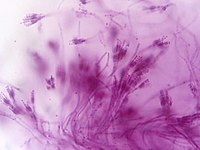
Evaluation of Aspergillus aculeatus GC-09 for the biological control of citrus blue mold caused by Penicillium italicum.
Sign Up to like & getrecommendations! Published in 2022 at "Fungal biology"
DOI: 10.1016/j.funbio.2021.12.006
Abstract: Blue mold caused by Penicillium italicum is a severe postharvest disease in citrus fruits. In this study, the fermentation product (FP-E) of Aspergillus aculeatus GC-09, an endophytic fungus isolated from a citrus plant, was found… read more here.
Keywords: citrus; blue mold; mold caused; microscopy ... See more keywords

Penicillium italicum: An Underexplored Postharvest Pathogen
Sign Up to like & getrecommendations! Published in 2020 at "Frontiers in Microbiology"
DOI: 10.3389/fmicb.2020.606852
Abstract: In the agricultural sector, citrus is one of the most important fruit genus in the world. In this scenario, Brazil is the largest producer of oranges; 34% of the global production, and exporter of concentrated… read more here.
Keywords: italicum underexplored; pathogen; italicum; penicillium italicum ... See more keywords

Antofine Triggers the Resistance Against Penicillium italicum in Ponkan Fruit by Driving AsA-GSH Cycle and ROS-Scavenging System
Sign Up to like & getrecommendations! Published in 2022 at "Frontiers in Microbiology"
DOI: 10.3389/fmicb.2022.874430
Abstract: Postharvest fungal infection can accelerate the quality deterioration of Ponkan fruit and reduce its commodity value. Penicillium italicum is the causal pathogen of blue mold in harvested citrus fruits, not only causing huge fungal decay… read more here.
Keywords: scavenging system; ros scavenging; fruit; asa gsh ... See more keywords

Alternative Management Approaches of Citrus Diseases Caused by Penicillium digitatum (Green Mold) and Penicillium italicum (Blue Mold)
Sign Up to like & getrecommendations! Published in 2021 at "Frontiers in Plant Science"
DOI: 10.3389/fpls.2021.833328
Abstract: Green mold (Penicillium digitatum) and blue mold (Penicillium italicum) are among the most economically impactful post-harvest diseases of citrus fruit worldwide. Post-harvest citrus diseases are largely controlled with synthetic fungicides such as pyrimethanil, imazalil, fludioxonil,… read more here.
Keywords: digitatum; green mold; mold; mold penicillium ... See more keywords

Antifungal Activity of Polymethoxylated Flavonoids (PMFs)-Loaded Citral Nanoemulsion against Penicillium italicum by Causing Cell Membrane Damage
Sign Up to like & getrecommendations! Published in 2022 at "Journal of Fungi"
DOI: 10.3390/jof8040388
Abstract: A major citrus postharvest pathogen, Penicillium italicum (P. italicum), causes substantial economic losses in citrus. In this study, a citral nanoemulsion containing polymethoxylated flavonoids (PMFs), the antimicrobial compounds from citrus, was prepared. The antifungal activity… read more here.
Keywords: antifungal activity; cell membrane; nanoemulsion; italicum ... See more keywords

Transcriptomics Integrated with Metabolomics Reveals 2-Methoxy-1, 4-Naphthoquinone-Based Carbon Dots Induced Molecular Shifts in Penicillium italicum
Sign Up to like & getrecommendations! Published in 2022 at "Journal of Fungi"
DOI: 10.3390/jof8050420
Abstract: Penicillium italicum (P. italicum), a citrus blue mold, is a pathogenic fungus that greatly affects the postharvest quality of citrus fruits with significant economic loss. Our previous research showed that 2-methoxy-1, 4-naphthoquinone (MNQ) inhibited the… read more here.
Keywords: based carbon; penicillium italicum; italicum; carbon dots ... See more keywords

Antioxidant and Toxic Activity of Helichrysum arenarium (L.) Moench and Helichrysum italicum (Roth) G. Don Essential Oils and Extracts
Sign Up to like & getrecommendations! Published in 2022 at "Molecules"
DOI: 10.3390/molecules27041311
Abstract: Helichrysum arenarium (L.) Moench (sandy everlasting) is the only species from genus Helichrysum Mill that grows spontaneously in Lithuania. The chemical composition of the essential oils (EOs) from inflorescences and leaves of H. arenarium wild… read more here.
Keywords: arenarium moench; helichrysum arenarium; helichrysum; activity ... See more keywords

Chemical Profile and Antimicrobial Activity of the Essential Oils of Helichrysum arenarium (L.) Moench. and Helichrysum italicum (Roth.) G. Don
Sign Up to like & getrecommendations! Published in 2022 at "Plants"
DOI: 10.3390/plants11070951
Abstract: This study compared the essential oils (EO) composition of Helichrysum arenarium (Bulgarian populations) with that of the cultivated species H. italicum. The EO composition of H. arenarium and H. italicum were analyzed via gas chromatography.… read more here.
Keywords: arenarium; helichrysum arenarium; essential oils; activity ... See more keywords